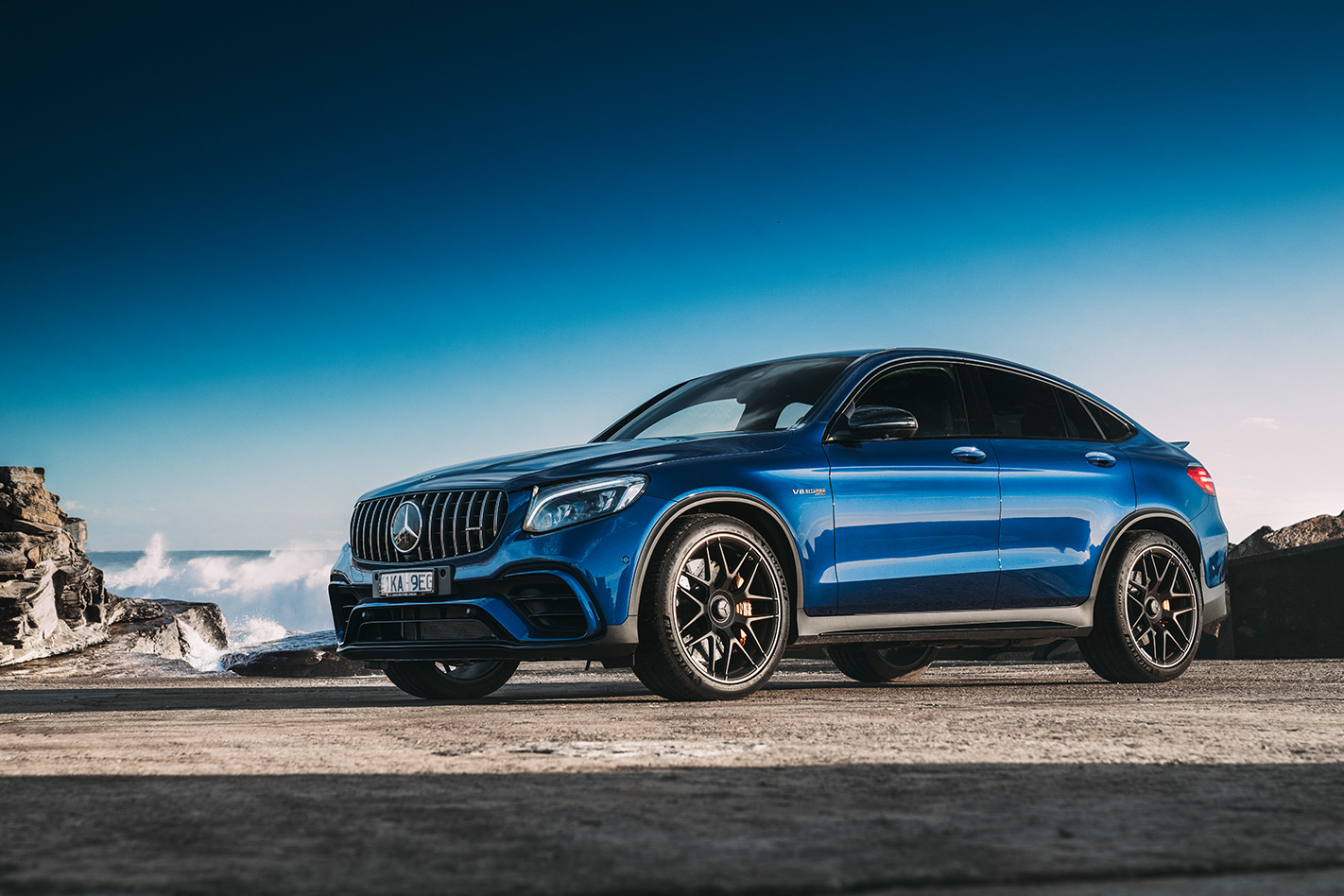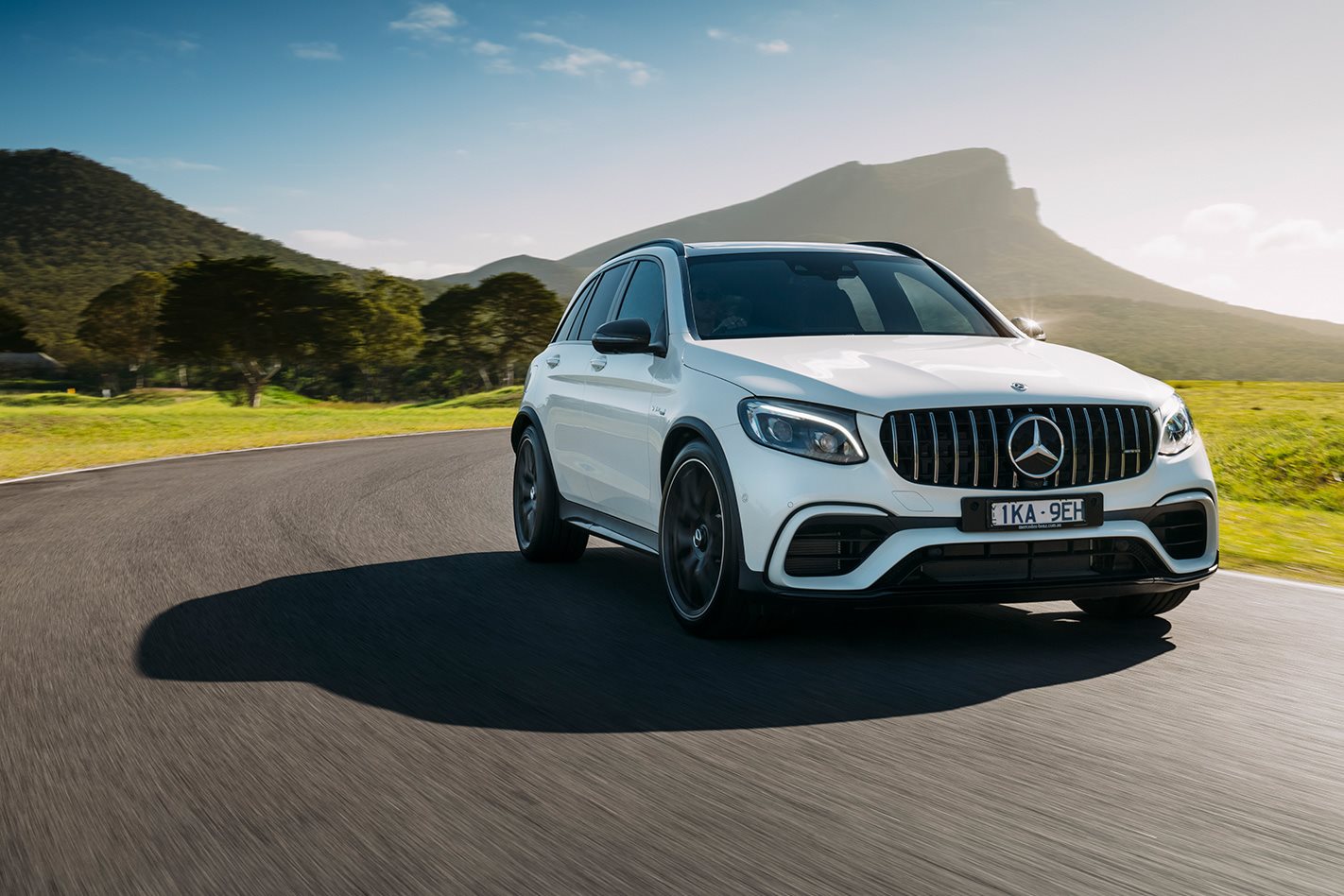WHAT IS IT
Mid-sized premium SUVs are hot property right now and while the market has settled on responsibly downsized six-cylinder engines for the hot versions, Mercedes-AMG has gone all-in with the same M177 V8 engine you’ll find in the C63 S. That alone will be enough to put it on a shortlist of one for some buyers.

WHY WE’RE TESTING IT
We’d had a drive in the GLC63 S on its international launch in Germany last year. Now that cars have started to arrive in Australia, we took the opportunity to see how the heavy-hitting SUV shaped up in local conditions.
MAIN RIVALS
Audi SQ5, Jeep Grand Cherokee Trackhawk, Maserati Levante S, Porsche Macan S
THE WHEELS VERDICT
The attractions of the Mercedes-AMG GLC63 S aren’t hard to grasp. It’s loud, extremely rapid and looks and feels reassuringly expensive. Subtlety? That’s a trickier quality to unearth in this hot GLC, but there’s a lot to be said for hot SUVs that get better the harder you drive ‘em.
PLUS: Pace; aggro handling; soundtrack; interior finish MINUS: Can feel clumsy; expensive
THE WHEELS REVIEW

WE could talk at length about the details of the Mercedes-AMG GLC63 S, but just know this. Set the car into Race mode and you can slide the tail as if you were driving a Mustang, accompanied by a hammering V8 soundtrack and the smell of fiery death from its rear Michelins. That right there is the sell. Everything else is just peripheral benefits.
You see, SUVs just don’t do this. Those sideways shots you see in car magazines? I’ll let you in on a trade secret, they’re often performed with the stability control switched off and the driver’s foot nowhere near the right-hand pedal; pure lift-off physics at work.
The GLC63 S will power oversteer to quite extravagant angles before the stability control decides you’re in danger of punching a 2.1 x 4.7m hole in the scenery, or cars and coffee crowd. I’ve never encountered another high-riding vehicle with this sort of throttle adjustability. Whether that’s a good thing or not is another debate altogether.

Should you choose not to pilot the car as if every day is Sunday at Summernats, there’s still enough to fill Mercedes’ order books. The M177 V8 engine is something you’re probably well familiar with, and in this guise it’s making 375kW @ 5500rpm and 700Nm @ 1750-40000rpm.
Although meaningful torque arrives fairly quickly, the engine likes a few revs on the board to feel and sound as if it’s working in its happy place. Try about 4000rpm for starters, at which point you start to get that hardening of the sound signature, and some choral accompaniment from the exhaust.

There’s a martial percussion of bangs and crackles on the overrun when the mode select switch is at the sportier end of its selection. Although you know that some of this sound engineering is exactly that, it’s enough to make its six-cylinder rivals sound a good deal more artificial in their aggression.
While the upfront appeal is easy to figure out, working into a seamless flow with a road isn’t quite so straightforward. The steering can feel heavy and slightly reluctant to join the fun. It’s accurate and has a consistent friction to its response, but this isn’t one of those ‘fingertip’ cars. Instead you find yourself manhandling it towards an apex and then letting the engine, stability control and rear e-diff figure the rest out between them.
The 4Matic+ all-wheel drive system has no fixed torque split, and body control, even when flung from one apex to another, is extremely good. The GLC corners flatter than many sports coupes, but it takes a bit of experimentation to find a suspension setting that allows the car to settle, especially into braking areas.

The Individual mode is often your friend here. While the engine, transmission and ESC can be set to angry in order to attack a tortuous country road, you’ll want to isolate the suspension, dialling it back a bit. In Comfort, it allows the car to breathe a little more easily with ruts and bumps. In any other mode it’s often too firm, unsettling the car unduly.
Expansion joints and surface imperfections send a booming jolt through the superstructure on anything other than racetrack-smooth hotmix. The throttle mapping also takes a little getting used to, lacking subtlety in the more aggressive modes. Poor road surfaces can have your foot bouncing off the pedal and flaring revs as if you’re doing an extreme caricature of taxi-driver foot.
Having nine gears also seems wholly superfluous in a car with 700Nm and a torque band wider than Moon River (claimed to be wider than a mile, which doesn’t narrow things down too much). There’s little in the way of shift busy-ness though and the shift logic settles unerringly and accurately onto the right gear on the way into a corner. Driven hard, it’s great. Part-throttle driving can occasionally have the wet-clutch ‘box clunking up a gear or sending a big flare of revs on downshift during a consistent cruise. It’s next to impossible to catch the GLC63 S off boost though, because even in manual mode, it’ll automatically downshift a couple of gears if it deems it necessary.
It’s seriously quick off the mark though, demolishing the sprint to 100km/h in 3.8 seconds with Race Start engaged. Compare that to a Porsche Macan Turbo, which takes an entire second longer (or 25 percent extra, if you prefer).

This brings us to a key consideration. What exactly is the GLC63’s rival set? Because it’s packing that V8 and more power than the six-pot SUVs we’re used to, it’s a lot more expensive. In wagon form its $164,900 and with the coupe tail (likely to account for around 30 percent of sales) it’s $171,900. Even the primo Porsche is $133k, while tackle like the Audi SQ5 is available for less than $100k. The GLC therefore comes within hailing distance of vehicles from the next class up in terms of price at least. The 423kW BMW X5M is $25k more, while the bargain Jeep Grand Cherokee Trackhawk delivers 522kW for just $135k.
As some form of recompense, Aussie cars are loaded to the gunwales with standard equipment. While Europe gets relatively sparsely equipped cars as standard, we get the AMG performance steering wheel, digital TV cluster, AMG splitter and diffuser, Night package, AMG performance exhaust, 21-inch alloys, and AMG performance seats as standard.

Should you find the seats too full-on, you can swap them at no-cost for a flatter, less showy option. For the first year of production, you’ll also be able to order the Edition 1 version, which features flics on the front spoiler, matte-grey paint, and matte-grey carbon centre console, ceramic brakes, diamond-stitched seats and a whole host of other cosmetic goodies.
Mercedes calls it a reward for early adopters, but you’ll need to fork out another $10,900 to be thus rewarded.
Looking expensive, sounding tough and having the capacity to smoke things away from the lights is about the extent of the skillset the Mercedes-AMG GLC63 S needs to succeed in Australia. Now that GLC production in Germany has come into its stride, the 63 S looks set to be a major contributor to Mercedes Australia’s bottom line.

There’s clearly a lot more to the hot GLC’s blend of talents than just the overt stuff, but it’s rarely a car that feels consistently satisfying. It’s great burbling about town and it’s eye-poppingly good when driven like a berserker. The other 70 percent of the time, it can feel a little less than perfectly resolved. For many, that won’t matter. Its highs are higher than anything else in its class and that’s all that matters.
You know what? It’s hard to argue against an extreme view for an extreme vehicle.
SPECS
Model: Mercedes-AMG GLC 63 S 4matic+ Engine: 3982cc, V8, dohc, 32v, turbocharged Max Power: 375kW @ 5500 to 6250rpm Max Torque: 700Nm @ 1750 to 4500rpm Transmission: 9-speed automatic Weight: 1935kg (SUV) 1945kg (coupe) 0-100km/h: 3.8 sec (claimed) Fuel economy: 10.9L/100km (European combined cycle) Price: $164,900 (SUV) $171,900 (coupe) On sale: June 2018






